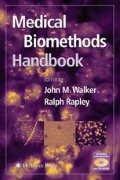Abstract
The enzyme-linked immunosorbent assay (ELISA) is typically used to detect and quantify antigen within biological fluids. Among the ELISA’s attributes are a very high level of sensitivity and robustness as well as being an extremely cost-effective assay that can be performed with only basic laboratory equipment. Having been developed over 30 yr ago (1), the ELISA remains an assay of choice for many routine medical and veterinary diagnostic assays, as well as being a vital assay in basic science research.
Access this chapter
Tax calculation will be finalised at checkout
Purchases are for personal use only
References
Engvall, E. and Perlman, P. (1971) Enzyme-linked immunosorbent assay (ELISA). Quantitative assay of immunoglobulin G. Immunochemistry 8(9), 871–874.
Peterson, E. M. (1981) ELISA: a tool for the clinical microbiologist. Am. J. Med. Technol. 47(11), 905–908.
Gervay, J. and McReynolds, K. D. (1999) Utilization of ELISA technology to measure biological activities of carbohydrates relevant in disease status. Curr. Med. Chem. 6(2), 129–153.
Johannsson, A., Stanley, C. J. and Self, C. H. (1985) A fast highly sensitive colorimetric enzyme immunoassay system demonstrating benefits of enzyme amplification in clinical chemistry. Clin. Chim. Acta 148(2), 119–124.
Bronstein, I., et al. (1989) Chemiluminescent assay of alkaline phosphatase applied in an ultrasensitive enzyme immunoassay of thyrotropin. Clin. Chem. 35(7), 1441–1446.
Cook, D. B. and Self, C. H. (1993) Determination of one thousandth of an attomole (1 zeptomole) of alkaline phosphatase: application in an immunoassay of proinsulin. Clin. Chem. 39(6), 965–971.
Chassany, O., et al. (1994) Testing of anti-HIV antibodies in saliva. Aids 8(5), 713–714.
Akanmu, A. S., et al. (2001) Evaluation of saliva-based diagnostic test kit for routine detection of antibodies to HIV. Afr. J. Med. Med. Sci. 30(4), 305–308.
Emmons, W. W., et al. (1995) A modified ELISA and western blot accurately determine anti-human immunodeficiency virus type 1 antibodies in oral fluids obtained with a special collecting device. J. Infect. Dis. 171(6), 1406–1410.
Siddiqi, M. A. and Abdullah. S. (1988) An “antigen capture” ELISA for secretory immunoglobulin A antibodies to hepatitis B surface antigen in human saliva. J. Immunol. Methods 114(1-2), 207–211.
Ukkonen, P., Koistinen, V., and Penttinen, K. (1977) Enzyme-immunoassay in the detection of hepatitis B surface antigen. J. Immunol. Methods 15(4), 343–353.
Wolters, G., et al. (1976) Solid-phase enzyme-immunoassay for detection of hepatitis B surface antigen. J. Clin. Pathol. 29(10), 873-879.
Wu, C. L., et al. (1999) Hepatitis C virus core protein fused to hepatitis B virus core antigen for serological diagnosis of both hepatitis C and hepatitis B infections by ELISA. J. Med. Virol. 57(2), 104–110.
Conway, D. J., et al. (1993) Immunodiagnosis of Strongyloides stercoralis infection: a method for increasing the specificity of the indirect ELISA. Trans. R. Soc. Trop. Med. Hyg. 87(2), 173–176.
Hopkins, R. M., et al. (1993) A field and laboratory evaluation of a commercial ELISA for the detection of Giardia coproantigens in humans and dogs. Trans. R. Soc. Trop. Med. Hyg. 87(1), 39–41.
Sastry, K. S., et al. (2003) Identification of Bacillus anthracis by a simple protective antigen-specific mAb dot-ELISA. J. Med. Microbiol. 52(Pt 1), 47–49.
Bayer, P. M., Fabian, B., and Hubl, W. (2001) Immunofluorescence assays (IFA) and enzymelinked immunosorbent assays (ELISA) in autoimmune disease diagnostics-technique, benefits, limitations and applications. Scand. J. Clin. Lab. Invest. 235, 68–76.
Bonagura, V. R., et al. (1989) The major rheumatoid factor cross-reactive idiotype in rheumatic disease. Int. Rev. Immunol. 5(2), 139–151.
Griesmacher, A. and Peichl, P. (2001) Autoantibodies associated with rheumatic diseases. Clin. Chem. Lab. Med. 39(3), 189–208.
Desai, M. P., Donde, U. M., and Khatkhatay, M. I. (2002) Improved performance of ELISAs for fertility assessment using common reagents and assay protocol as evidence from quality control studies. J. Immunoassay Immunochem. 23(2), 163–180.
Arilla, M. C., et al. (2001) Quantification in mass units of group 1 grass allergens by a monoclonal antibody-based sandwich ELISA. Clin. Exp. Allergy 31(8), 1271–1278.
Wei, Y., et al. (2003) A sensitive sandwich ELISA for the detection of trace amounts of cashew (Anacardium occidentale L.) nut in foods. J. Agric. Food Chem. 51(11), 3215–3221.
Yamashita, H., et al. (2001) Sandwich enzyme-linked immunosorbent assay system for microdetection of the wheat allergen, Tri a Bd 17 K. Biosci. Biotechnol. Biochem. 65(12), 2730–2734.
Snow, D. H. (1993) Anabolic steroids. Vet. Clin. North Am. Equine Pract. 9(3), 563–576.
Pescovitz, O. H., et al. (1986) Production of monoclonal antibodies against human growth hormone releasing hormone and their use in an enzyme-linked immunosorbent assay (ELISA). J. Immunol. Methods 94(1-2), 257–262.
Meyer, H. H. and Hoffmann, S. (1987) Development of a sensitive microtitration plate enzymeimmunoassay for the anabolic steroid trenbolone. Food Addit. Contam. 4(2), 149–160.
Tanaka, H. and Shoyama, Y. (1999) Monoclonal antibody against tetrahydrocannabinolic acid distinguishes Cannabis sativa samples from different plant species. Forensic Sci. Int. 106(3), 135–146.
Kerrigan, S. and Phillips, W. H. Jr. (2001) Comparison of ELISAs for opiates, methamphetamine, cocaine metabolite, benzodiazepines, phencyclidine, and cannabinoids in whole blood and urine. Clin. Chem. 47(3) 540–547.
Author information
Authors and Affiliations
Editor information
Editors and Affiliations
Rights and permissions
Copyright information
© 2005 Humana Press Inc., Totowa, NJ
About this protocol
Cite this protocol
Jordan, W.J. (2005). Enzyme-Linked Immunosorbent Assay. In: Walker, J.M., Rapley, R. (eds) Medical Biomethods Handbook. Springer Protocols Handbooks. Humana Press. https://doi.org/10.1385/1-59259-870-6:419
Download citation
DOI: https://doi.org/10.1385/1-59259-870-6:419
Publisher Name: Humana Press
Print ISBN: 978-1-58829-288-9
Online ISBN: 978-1-59259-870-0
eBook Packages: Springer Protocols

